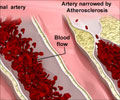Cardiovascular disease impacts middle-income countries the most, highlighting the need for targeted prevention and care to address this growing health crisis.

European Society of Cardiology: the 2023 Atlas of Cardiovascular Disease Statistics
Go to source). The fourth edition of ESC Atlas statistics again demonstrate that CVD is the most common cause of death in the 55 ESC member countries studied. There are over 3 million deaths due to CVD per year – the equivalent of 8,500 deaths per day – which represents 37.4% of all deaths annually. Of note, age-standardised mortality rates (ASMRs) were at least 2.5-times higher in middle-income compared with high-income countries. Between 1990 and 2021, median CVD ASMRs decreased by more than 50% in all high-income countries, but in middle-income countries, the decrease was less than 12%.
‘#Cardiovasculardisease (CVD) takes a heavier toll on middle-income countries: 46% of male and 53% of female deaths are due to #CVD, compared to 30% and 34% in high-income countries. #hearthealth’





According to the latest data from ESC member countries: The estimated age-standardised potential years of life lost was more than 3-times higher in middle-income compared with high-income countries.
Professor Adam Timmis, first author of the report, said: “The new statistics on deaths due to CVD illustrate the scale of the problem and underscore the urgent need for effective strategies in prevention and management. The inequalities between middle- and high-income ESC member countries likely reflect heterogeneous exposures to a range of environmental, socioeconomic and clinical risk factors.”
According to the latest data from ESC member countries:
- Around one-quarter of persons aged ≥15 years were estimated to be tobacco-product users (25.4%), with rates as high as 40.9% among males in middle-income countries.
- Hypertension affected >40% of both sexes in middle-income countries vs. <30% of females and <40% of males in high-income countries.
- The prevalence of diabetes was 7.7% in middle-income countries vs. 6.0% in high-income countries.
- More than half (55%) of people were overweight and 17% were obese, with similarly high rates for middle-income and high-income countries.
Treatment Disparities Contribute to Higher CVD Mortality
Professor Timmis also pointed to new data suggesting that treatment factors may contribute to inequalities in CVD mortality, with middle-income countries substantially under-resourced in terms of specialist staffing, and diagnostic and therapeutic procedure rates compared with high-income countries. Across ESC member countries, there were twice as many cardiologists per million inhabitants in high-income than middle-income countries (100 vs. 55, respectively). In addition, middle-income countries reported lower rates per million of percutaneous coronary intervention (1,355 vs. 2,330, respectively), transcatheter aortic valve implantation (4.0 vs. 153.4) and pacemaker implantation (147.0 vs. 831.9) compared with high-income countries.The data presented in the fourth edition have been enriched with economic data from the ESC’s Burden of CVD project developed in collaboration with Nuffield Department of Population Health, Oxford University.2 Overall, CVD is estimated to cost the EU economy €282 billion annually – a cost of €630 per person, ranging from €381 in Cyprus to €903 in Germany. Of the total cost of CVD, 46% was due to healthcare, 9% to social care, 28% to informal care and 17% to productivity loss.
Advertisement
The ESC Atlas of Cardiology project is widely recognised as a pivotal tool for leveraging cardiovascular care. It presents the evidence of trends, disparities, gaps and associations between fundamental variables, not just as one snapshot, but over time. Up-to-date statistics enable policymakers, healthcare providers and researchers to allocate resources efficiently, design targeted interventions and monitor the progress of public health initiatives. Atlas data were recently presented to EU health ministers in ongoing discussions towards building national and EU Cardiovascular Health Plans.
Advertisement
“The ESC is committed to advancing cardiovascular health through research, education and advocacy. ESC Atlas is a testament to that commitment and will serve as a valuable resource for all stakeholders involved in cardiovascular health,” concluded Professor Vardas.
Reference:
- European Society of Cardiology: the 2023 Atlas of Cardiovascular Disease Statistics - (https://academic.oup.com/eurheartj/advance-article/doi/10.1093/eurheartj/ehae466/7741182)
Source-Eurekalert











